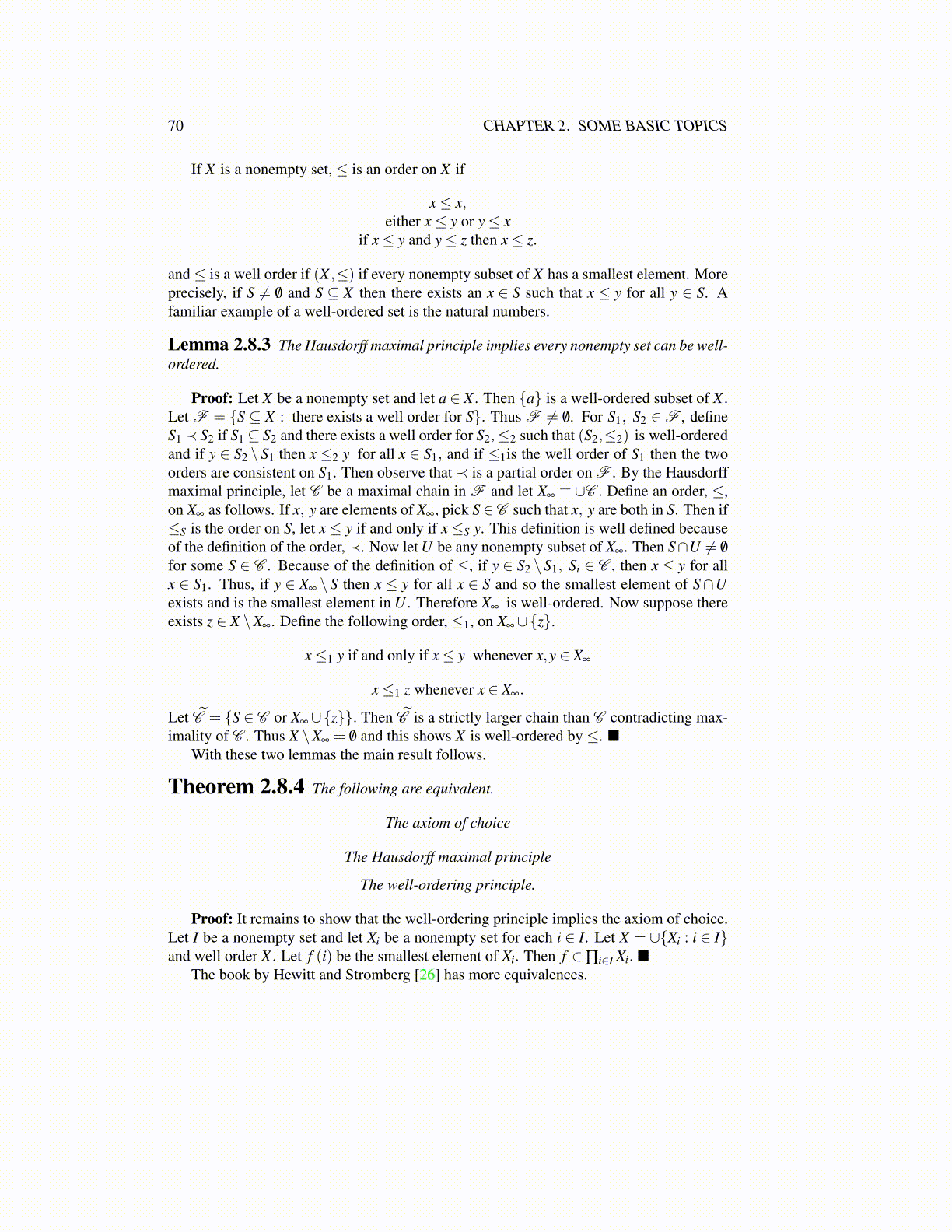
70 CHAPTER 2. SOME BASIC TOPICS
If X is a nonempty set, ≤ is an order on X if
x≤ x,either x≤ y or y≤ x
if x≤ y and y≤ z then x≤ z.
and≤ is a well order if (X ,≤) if every nonempty subset of X has a smallest element. Moreprecisely, if S ̸= /0 and S ⊆ X then there exists an x ∈ S such that x ≤ y for all y ∈ S. Afamiliar example of a well-ordered set is the natural numbers.
Lemma 2.8.3 The Hausdorff maximal principle implies every nonempty set can be well-ordered.
Proof: Let X be a nonempty set and let a ∈ X . Then {a} is a well-ordered subset of X .Let F = {S ⊆ X : there exists a well order for S}. Thus F ̸= /0. For S1, S2 ∈F , defineS1 ≺ S2 if S1 ⊆ S2 and there exists a well order for S2,≤2 such that (S2,≤2) is well-orderedand if y ∈ S2 \ S1 then x ≤2 y for all x ∈ S1, and if ≤1is the well order of S1 then the twoorders are consistent on S1. Then observe that ≺ is a partial order on F . By the Hausdorffmaximal principle, let C be a maximal chain in F and let X∞ ≡ ∪C . Define an order, ≤,on X∞ as follows. If x, y are elements of X∞, pick S ∈C such that x, y are both in S. Then if≤S is the order on S, let x≤ y if and only if x≤S y. This definition is well defined becauseof the definition of the order, ≺. Now let U be any nonempty subset of X∞. Then S∩U ̸= /0for some S ∈ C . Because of the definition of ≤, if y ∈ S2 \ S1, Si ∈ C , then x ≤ y for allx ∈ S1. Thus, if y ∈ X∞ \ S then x ≤ y for all x ∈ S and so the smallest element of S∩Uexists and is the smallest element in U . Therefore X∞ is well-ordered. Now suppose thereexists z ∈ X \X∞. Define the following order, ≤1, on X∞∪{z}.
x≤1 y if and only if x≤ y whenever x,y ∈ X∞
x≤1 z whenever x ∈ X∞.
Let C̃ = {S ∈ C or X∞∪{z}}. Then C̃ is a strictly larger chain than C contradicting max-imality of C . Thus X \X∞ = /0 and this shows X is well-ordered by ≤. ■
With these two lemmas the main result follows.
Theorem 2.8.4 The following are equivalent.
The axiom of choice
The Hausdorff maximal principle
The well-ordering principle.
Proof: It remains to show that the well-ordering principle implies the axiom of choice.Let I be a nonempty set and let Xi be a nonempty set for each i ∈ I. Let X = ∪{Xi : i ∈ I}and well order X . Let f (i) be the smallest element of Xi. Then f ∈∏i∈I Xi. ■
The book by Hewitt and Stromberg [26] has more equivalences.